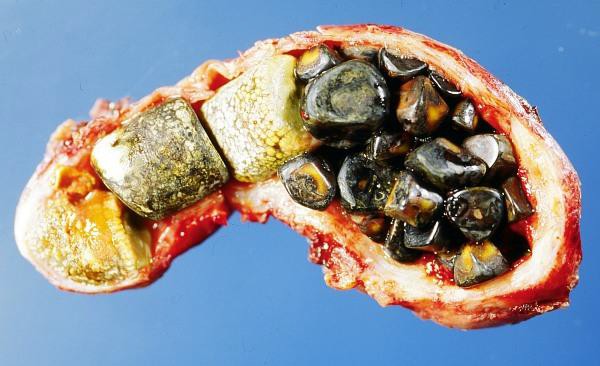Chapter 4: Common Digestive Problems
4.3 Gallstones
It is estimated that up to 1 million Americans are hospitalized annually as a result of gallstones, making it the most common of all digestive diseases.[1] Gallstones are formed when bile hardens in the gallbladder. 80% of gallstones are a result of cholesterol precipitation, while 20% are the result of bile pigment precipitation.[2] The cause of gallstones is not fully understood. The way in which gallstones are formed is shown in the following video.
Video Link: Gallstones (0:27)
The following figure shows a severe case of gallstones.

Many people do not experience symptoms from gallstones. They are usually discovered during examination for another health condition. However, some people experience an “attack” or pain that results from blockage of the bile ducts.
Prevention of gallstones is accomplished by maintaining a healthy weight and eating a diet high in fiber and low in simple carbohydrates. If there are no symptoms, treatment is usually not needed. In those who are having gallbladder attacks, surgery to remove the gallbladder, called a cholecystectomy, is typically recommended since the gallbladder is not considered an essential organ. After surgery, bile then flows directly from the liver into the small intestine. In those who are unable to have surgery, medication to try to dissolve the stones or shock wave lithotripsy may be tried.
In the developed world, 10–15% of adults have gallstones. Rates in many parts of Africa, however, are as low as 3%. Gallbladder and biliary related diseases occurred in about 104 million people (1.6%) in 2013 and they resulted in 106,000 deaths. Women more commonly have stones than men and they occur more commonly after the age of 40. Certain ethnic groups have gallstones more often than others. For example, 48% of American Indians have gallstones. Once the gallbladder is removed, outcomes are generally good.
- Bar-Meir S. (2001) Gallstones: Prevalence, diagnosis and treatment. The Israel Medical Association Journal 3(2): 111. ↵
- https://www.niddk.nih.gov/health-information/digestive-diseases/gallstones ↵
Bile is produced in the liver and takes part in fat digestion. Bile acts as an emulsifier, or detergent. It, along with phospholipids, breaks the large triglyceride droplets into smaller triglyceride droplets that increase the surface area accessible for digestive enzymes.
The gallbladder is a GI tract accessory organ that stores bile.

